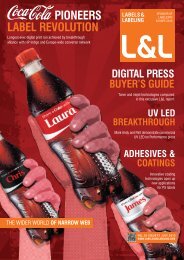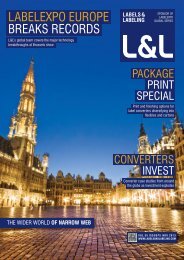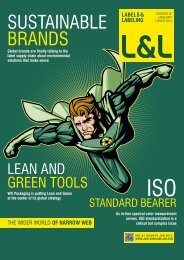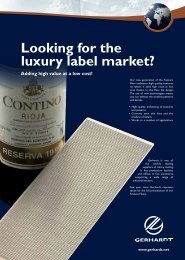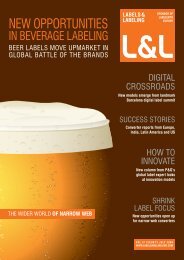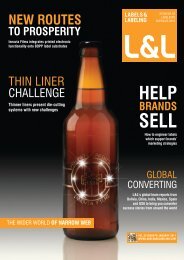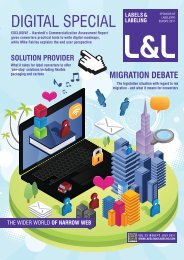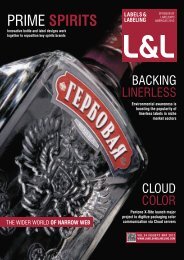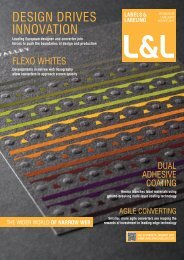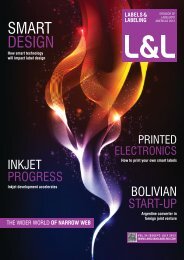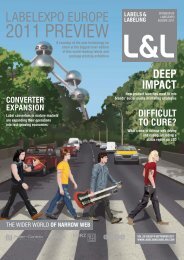THE DATA FRONT
Download as PDF - Labels & Labeling
Download as PDF - Labels & Labeling
- No tags were found...
Create successful ePaper yourself
Turn your PDF publications into a flip-book with our unique Google optimized e-Paper software.
Labels&Labeling |83<br />
to pharmaceutical products.<br />
Two-dimensional codes are also still going strong. Each 2-D<br />
code can store far more characters than linear barcodes in a<br />
smaller space, but require optically-based scanners for reading<br />
and decoding. Commonly used 2-D codes for logistical labeling<br />
include PDF417, a stacked linear symbol; and the Data Matrix<br />
code comprising cells arranged in a square or rectangular<br />
pattern. GS1 is currently developing Data Matrix encoding<br />
standards specifically for the pharmaceutical and healthcare<br />
industries. Other 2-D developments include the use of portable<br />
technologies to extend barcode capabilities, including data<br />
storage/retrieval, track and trace applications, or point-of-sale<br />
applications. These emerging technologies owe much to the<br />
Quick Response (QR) encrypted matrix barcode developed in<br />
Japan by Denso Wave in 1994. Today, many Japanese people<br />
use the camera in their mobile (cell) phones to scan QR codes<br />
for hyperlinks with websites. With suitable marketing support,<br />
extensions of this practice could eventually take off outside<br />
Japan, although not necessarily with QR codes alone.<br />
For many, RFID technology (see boxout) is a logical<br />
progression to take logistics labeling to an even higher level.<br />
RFID tags are commonly used to automatically identify larger<br />
items, such as pallets and cartons, beyond the line of sight of<br />
the reader. Besides providing a valuable real-time record of<br />
inventories, pallet scans allow retailers to quickly check goods<br />
received at distribution centers or stores. Applied to cases or<br />
cartons, a basic single-use tag allows users to visibly trace<br />
product movements. For example, in retail clothing chain<br />
applications, they can validate tagged garments or boxes at<br />
high speeds and label them for shipping to the destination store<br />
with a minimum need for warehousing. RFID tags also ensure<br />
that returnable transit items (RTIs), such as plastic crates<br />
for fresh foods, remain visible within the supply chain as aid<br />
towards better asset management.<br />
Item-level tagging will supply further impetus for RFID<br />
technology. Its potential includes closed-loop applications<br />
involving promotional tracking, in-store inventory management,<br />
and brand authentication. Retail-specific software packages<br />
from companies like Microsoft, Intel, IBM and Oracle are<br />
already available. Current developments have evolved by<br />
combining the latest UHF tags with the Gen 2 protocol.<br />
Designs based on single-loop antenna, or integrated circuits,<br />
have allowed inlay manufacturers to produce powerful, but<br />
relatively small tags. Some allow near-field operation based on<br />
a magnetic coupling, as well as far-field read/write sensitivities<br />
over a range of 12 feet or so (3.5m) using magnetic/electric<br />
couplings. The latest near-field Gen 2 UHF tags are claimed<br />
to give highly accurate data transference, while overcoming<br />
previous problems with radio frequency interference when<br />
tagging either liquid-based or metallic products. These benefits<br />
are already widening pharmaceutical and healthcare item-level<br />
applications.<br />
Despite the hype, HF tags will still remain in wide use for<br />
a variety of applications. In fact, this area is undergoing its<br />
own metamorphosis in respect of unit costs and technical<br />
developments, including the possibility of inlays based on<br />
printed electronics. As far as label converters are concerned,<br />
both UHF and HF tags come in two forms. The adhesive-free<br />
'dry inlays' are supplied in a continuous web, while<br />
adhesive-backed 'wet inlays' have conventional release liners<br />
to facilitate die cutting. The latter are inserted into pre-printed<br />
pressure-sensitive labelstock and delaminated in-line on the<br />
same machine. Because reading and verifying finished tagged<br />
labels takes longer than the printing operation, it is usual to<br />
print the label first and insert the inlays separately as a roll-fed,<br />
off-line<br />
operation.<br />
With swing<br />
ticket production,<br />
wet tags allow the<br />
tag to adhere to one<br />
of the two webs of paper/<br />
board which pass through the<br />
press. During the past five years many<br />
types of narrow web inlay inserters have<br />
appeared, equipped with sophisticated devices<br />
to read, verify and reject faulty tags before delivery.<br />
Pricing trends<br />
While price is not the only issue for implementing RFID<br />
systems, many potential users have an acute interest in<br />
lower-priced tags to facilitate item-level tagging. Earlier this year<br />
the Chinese manufacturer Invengo Technology stirred things<br />
up by reducing the price of its Gen 2 passive UHF inlays from<br />
7.7 cents to 5.8 cents, although buyers must order a minimum<br />
of five million units. Invengo is also opening a manufacturing<br />
operation in Virginia to serve the North American market.<br />
Interestingly, Avery Dennison RFID introduced Gen 2 inlays<br />
for 7.9 cents in late 2005 and prompted a pricing war at the<br />
time. One of its latest products is the AD-805 tag inlay. Maggie<br />
Bidlingmaier, global director of sales and marketing, says the<br />
postage stamp-sized product is ideal for tagging small items<br />
within the retail and healthcare environments. This includes<br />
plastic or cardboard blister packs, which are not always<br />
oriented uniformly. 'The new tag provides an incredible read<br />
range in difficult-use cases with an edge-on orientation. A wide<br />
variety of industries are showing an interest in it.' Toronto-based<br />
GAO RFID offers a similar edge-on UHF tags for retail<br />
applications, this time based on Avery Dennison's 96-bit inlay.<br />
End-users can use it with their desktop printers to add linear<br />
barcodes and sequential numbering.<br />
"The unknown issue is whether<br />
the latest techniques for printed<br />
electronics pose a challenge to<br />
conventional inlay manufacturing<br />
methods"<br />
Unit costs may be important, but the key driver for RFID<br />
adoption is return on investment, says Samuli Strőmberg,<br />
vice-president marketing RFID at UPM Raflatac: 'Through<br />
climbing the learning curve the industry has learnt one key<br />
thing: identifying and communicating the possibilities of<br />
ROI. Talking solely of costs rarely helps with that. The recent<br />
success we have experienced in all retail-related projects,<br />
including the huge pull for item-level tagging, relates to<br />
identifying the ROI and forgetting the stories that costs should<br />
be lower than they currently are.' He also feels that it is highly<br />
unlikely that the markets for the various types of passive<br />
UHF, HF and NFC tags will mix: 'The applications are mostly<br />
separate at the moment. Also, if the technology is used in<br />
may 2009 | L&L



